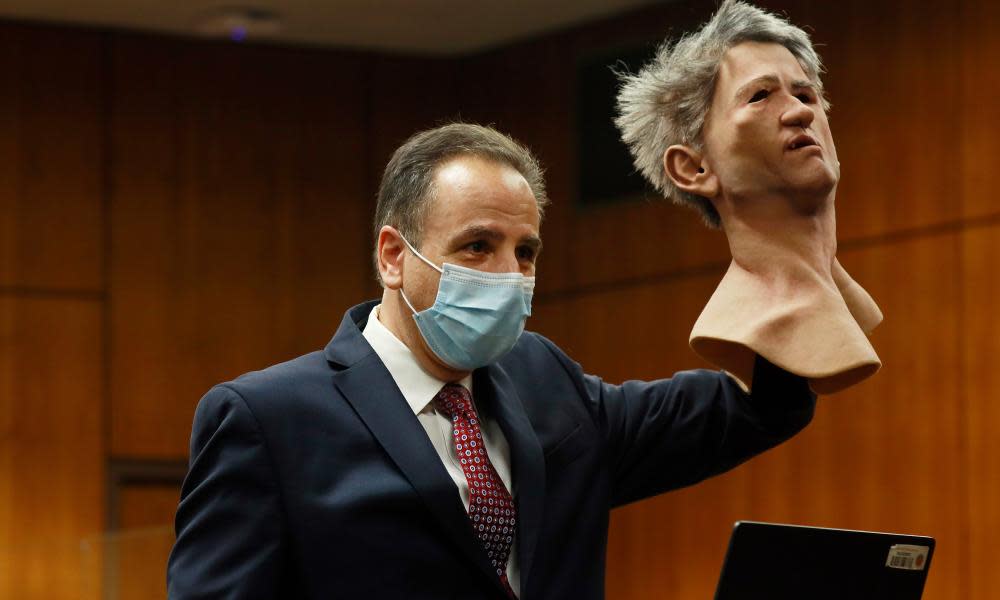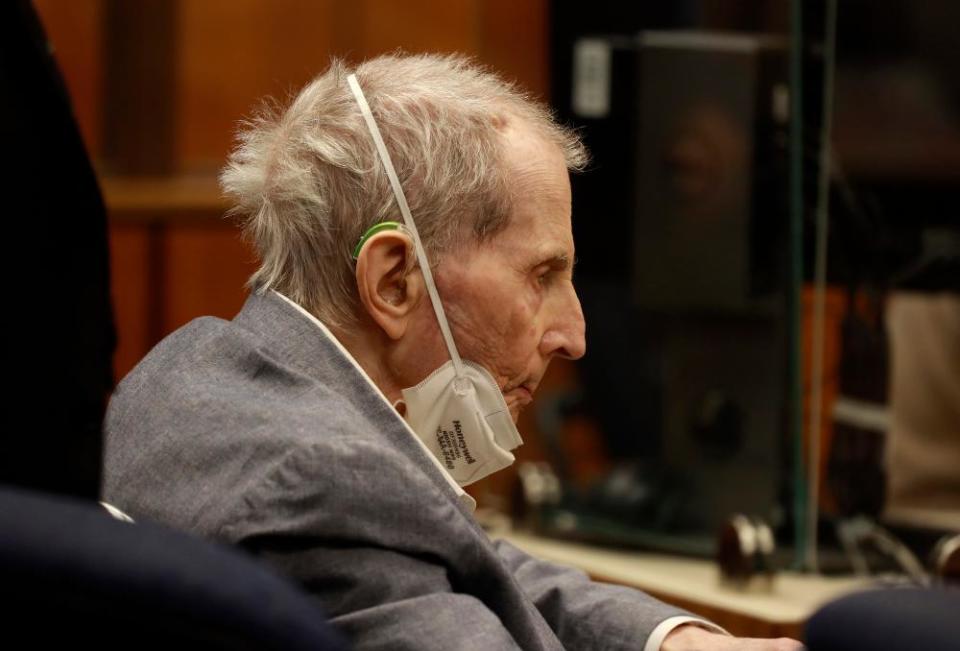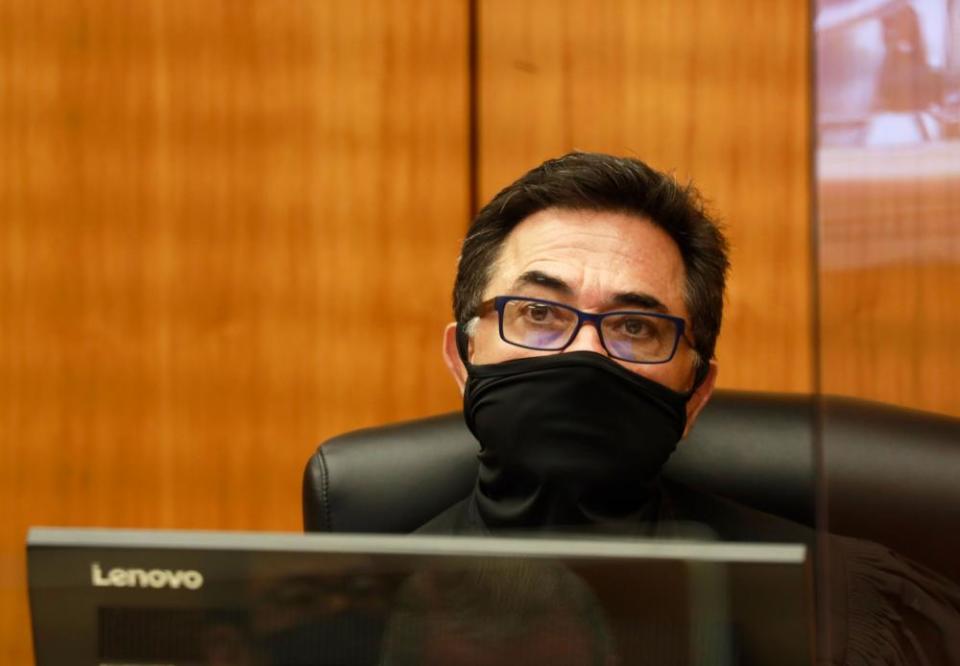Cockroaches, staged wrestling and more lies: the peculiar murder trial of Robert Durst

- Oops!Something went wrong.Please try again later.
The latest and, most likely, last trial of Robert Durst, the wily, silver-tongued New York real estate heir who has spent half a lifetime seeking to explain away a string of shocking deaths in his midst, was always going to be a lurid affair. But the reality – of murder, dismemberment, kooky disguises and a compulsion to talk about it all – has outstripped all expectations.
Over the past four months, a court in suburban Los Angeles has heard Durst, now 79 and in poor health, repeatedly admitting that he was a liar and a perjurer. Even he, he said, had difficulty believing the central alibi for the murder at the heart of the case.
Related: Robert Durst has beaten the odds for 40 years – now he faces his last murder trial
At the outset, Durst said he looked forward to “making a fool” of the prosecution on the witness stand. But the lead prosecutor, cold case specialist John Lewin, ended up hammering Durst so hard that after 38 hours of relentless cross-examination the judge urged Lewin to stop. “At some point, there’s a limit,” the judge said.
In late June, the proceedings featured a bizarre argument over Durst’s urine bag, which Lewin volunteered to change during a lunch break only to be rebuked by Durst after. As the lawyers began their closing arguments last week, they clashed over an equally bizarre argument involving a photograph of a soup bowl filled with cockroaches.
In between, Durst’s two high-priced lawyers found themselves tussling with each other on the courtroom floor – their way of re-enacting a 2001 shooting death involving Durst – and arguing to the jury that it was purely accidental. Durst, confined to a wheelchair, rasped approvingly: “That’s a full-service law firm.”

Six years ago, Durst’s strange story – the disappearance of his wife Kathie in 1982, the cold-blooded murder of his best friend Susan Berman in Los Angeles 18 years later, and the violent 2001 death of a roommate in Galveston, Texas, where Durst was living under cover as a deaf-mute woman – transfixed viewers of the hit television documentary series The Jinx.
Durst’s motives for giving hours of interviews on camera were unclear, but the filmmakers found a vital clue pointing to his possible guilt in the Berman murder, and Durst was caught on a hot mic in a bathroom muttering: “What the hell did I do? Killed them all, of course.”
The night before the series finale aired in the US in March 2015, Durst was arrested in New Orleans, where he had checked into a hotel wearing a latex face mask and using an alias. He was held without bail and later convicted for illegal firearms possession.
The Los Angeles district attorney’s office soon jumped back into the case, seeing an opportunity to charge Durst in the unsolved Berman case and wrap the rest of his story into one final effort to make him accountable for all of it. For years, prosecutors on both coasts had suspected that Durst was responsible for his wife’s disappearance and that he murdered Berman because he saw her as a liability. She knew what he had done, the theory went, and had helped him misdirect police at the start of the investigation – all of which made Durst fearful that, despite her background as the daughter of a Las Vegas gangster and her belief in unswerving loyalty to her friends, she might cut a deal with law enforcement and talk.
Both parts of this theory were difficult to prove, however. Kathie Durst’s body, which prosecutors now believe was dumped in the Pine Barrens in southern New Jersey, was never found, and she wasn’t officially declared dead until 2017. Law enforcement could not place Durst in Los Angeles at the time of Berman’s death, much less connect him to the gun used to shoot her in the back of the head. All they had was an anonymous letter to the Beverly Hills police on which someone had scrawled the single word “cadaver”.
Throughout the years, Durst strongly denied responsibility in either case, and that didn’t change even in the wake of the Berman murder, when he went on the run to Texas, shot his roommate, Morris Black, dismembered him with a bow saw and paring knife and threw the remains into Galveston Bay. Durst was tried for murder in that case but – to the astonishment of just about everybody – won acquittal after arguing that he had acted in self-defense.
The Jinx put him back on a collision course with the criminal justice system, because Durst made several damaging new statements on camera, particularly about the Berman case. First, he agreed with the film-makers that only the killer could have written the “cadaver” note. Then he blanched when they showed him a sample of his own handwriting that looked remarkably similar and repeated the same misspelling of Beverly Hills on the envelope.
Even before this latest trial began, Durst’s lawyers acknowledged that he did in fact travel to Los Angeles around the time of Berman’s murder – something he had denied for years – and wrote the “cadaver” note. The story his lawyers presented at trial was that Durst had walked into Berman’s house and discovered her lifeless body already splayed out on the floor. He didn’t call the police directly for fear of coming under suspicion as the murderer.

Under cross-examination, several elements of this new defense fell apart. At one point, Lewin asked: “Isn’t it true that you are caught in a giant lie right now?” Durst initially responded: “No, no and no!” Then he added: “I did what I did, because I did what I did because I am who I am.”
As prosecutors summed up the case at the end of last week, they analysed Durst’s shifting stories and espoused theories about why and when he’d lied. Durst himself said on the witness stand:. “I have lied about several things.”
Lewin’s co-counsel, Habib Balian, sought to illustrate the toxic effect of those lies by showing the jury two pictures – one of a single cockroach dangling over a bowl of soup, and the other a bowl crawling with dozens of cockroaches.
“That’s disgusting!” judge Mark Windham exclaimed when shown the photographs out of the presence of the jury.
“The man dismembered a body,” Balian retorted. “So the cockroaches over a bowl of soup pale in comparison.” The photographs were ultimately deemed acceptable for closing arguments.
“Don’t let [Durst] run from the truth any more,” Balian told the jury at the end of a marathon nine-hour summation. “He has gotten away with murder too long.”
In response, Dick DeGuerin, Durst’s lead lawyer who previously represented him in the Morris Black case, returned to many of the arguments he made in his opening statement in May – that no direct evidence tied Durst to the gun that killed Berman and that the case was built not on facts but on an unreliable television show.
“I wouldn’t blame you after hearing what you’ve heard … if you hate Bob Durst and believe he’s a liar,” DeGuerin told the jury. “But being a liar doesn’t make him a killer.”
The jury is expected to take charge of the case by midweek.

